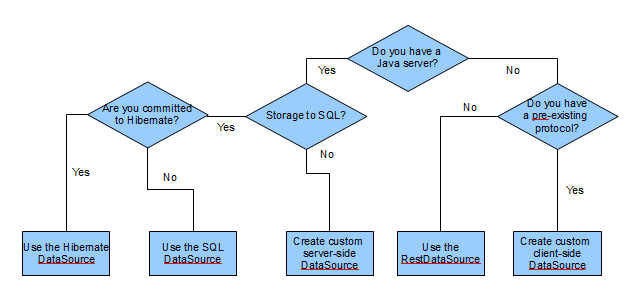Interface ClientServerIntegration
Client-Server Integration
Like client-server desktop applications, Smart GWT browser-based applications interact with remote data and services via background communication channels. Background requests retrieve chunks of data rather than new HTML pages, and update your visual components in place rather than rebuilding the entire user interface.DataSources
First you must create
DataSources that describe the objects from your
object model that will be loaded or manipulated within your application. All of Smart GWT's
most powerful functionality builds on the concept of a DataSource, and because of Smart GWT's
databinding framework (see DataBoundComponent), it's as
easy to create a DataSource that can configure an unlimited number of components as it is to
configure a single component.
For background information on how to create DataSources,
bind components to DataSources and
initiate DSRequests, please see the Data Binding
chapter of the Smart GWT Quickstart Guide.
Data Integration
DataSources provide a data-provider agnostic API to Smart GWT Visual Components that allow them to perform the 4 CRUD operations (Create, Retrieve, Update, Delete). By "agnostic" we mean that the implementation details - the nuts and bolts of how a given DataSource actually retrieves or updates data - are unknown to bound Smart GWT components. One effect of this is that DataSources are "pluggable": they can be replaced without affecting the User Interface.
When a visual component, or your own custom code, performs a CRUD
operation on a DataSource, the DataSource creates a DSRequest
(DataSource Request) representing the operation. "Data Integration" is the process of
fulfilling that DSRequest by creating a corresponding DSResponse (DataSource Response), by using a variety of possible
approaches to connect to the ultimate data provider.
There are two main approaches to integrating DataSources with your server technology:
Server-side integration: DataSource requests from the browser arrive as Java Objects on the server. You deliver responses to the browser by returning Java Objects. The various server-side integration possibilities are discussed later in this article.Client-side integration: DataSource requests arrive as simple HTTP requests which your server code receives directly (in Java, you use the Servlet API or .jsps to handle the requests). Responses are sent as XML or JSON which you directly generate.

Smart GWT supports, out of the box, codeless connectivity to various kinds of common data providers, including SQL and Hibernate. Smart GWT also provides functionality and tools for accelerated integration with broad categories of data providers, such as Java Object-based persistence mechanisms (JPA, EJB, MyBatis, in-house written systems), and REST and WSDL web services in XML or JSON formats. Ultimately, a DataSource can be connected to anything that is accessible via HTTP or HTTPS, and also to in-browser persistence engines such as Google Gears.
Choosing a Data Integration Approach
This section aims to help you decide which of the many possible data integration approaches is best for your particular circumstances. The recommendations given here will guide you to the approach that involves the least effort.

- If you have a Java server:
- If your ultimate storage is a SQL database:
- Use the SQLDataSource unless you
have a very large amount of pre-existing JPA or Hibernate code - small amounts of
business logic can be easily migrated. Be sure to read the overview of
SQLDataSource vs JPA/Hibernatein order to understand the large benefits the SQLDataSource provides - Derive DataSource
definitions from existing tables or Hibernate mappings using the
autoDeriveSchemafeature, or from Java Beans via theschemaBeanfeature. Or, use theAdmin Consoleto generate tables from DataSource definitions you create by hand - If your ultimate storage is not a SQL database:
- If your persistence is based on Java
Beans, use the
schemaBeanfeature to derive DataSource definitions from any Java bean - write a
custom DataSourcethat provides the CRUD operations you want to support. - Whether or not
your storage is SQL, add business logic either declaratively in the DataSource
definition, via
DMI, or any combination of the two:- The <criteria> and <values> properties of an
OperationBindingallow you to dynamically set data values at transaction-processing time, using built-inVelocity support - Override the
validate()method of the DataSource to provide extra custom validations - just callsuperto obtain the list of errors derived from Smart GWT validations, then add to that list as required with your own custom code - Override the
execute()method of the DataSource to add extra processing either before or after the Smart GWT processing - Use
Transaction Chainingto dynamically set data values according to the results of earlier transactions - For SQL
DataSources, use
SQL Templatingto change, add to or even completely replace the SQL sent to the database, and to implement special query requirements - For JPA DataSources, use
custom JQL queriesto implement special query requirements - For Hibernate DataSources, use
custom HQL queriesto implement special query requirements
the server integration overview. - The <criteria> and <values> properties of an
- If you do not have a Java server:
- If you are not obliged to use a
pre-existing network protocol, use the
RestDataSource - Otherwise, use
client-side data integrationfeatures to create a custom client-side DataSource that adapts the DataSource protocol to your existing services
RPCs: Unstructured Server
Communication
Smart GWT also supports "unstructured" client-server operations. These
RPCRequests (Remote Procedure Call Requests) are a low-level,
very flexible mechanism for custom client-server communications. In an nutshell, RPCRequests:
- may contain arbitrary data
- are always initiated by custom code (a call to
RPCManager.send()), and have their responses handled by custom code (the callback passed tosend())
RPCRequests are
relatively rare. Most client-server communications are better done in a structured fashion
using a DSRequest (DataSource Request). Note that
any RPCRequest can alternatively be framed as a DataSource fetch; depending on the
circumstances, this may be more convenient.
See the RPCManager documentation for further information on RPCRequests.